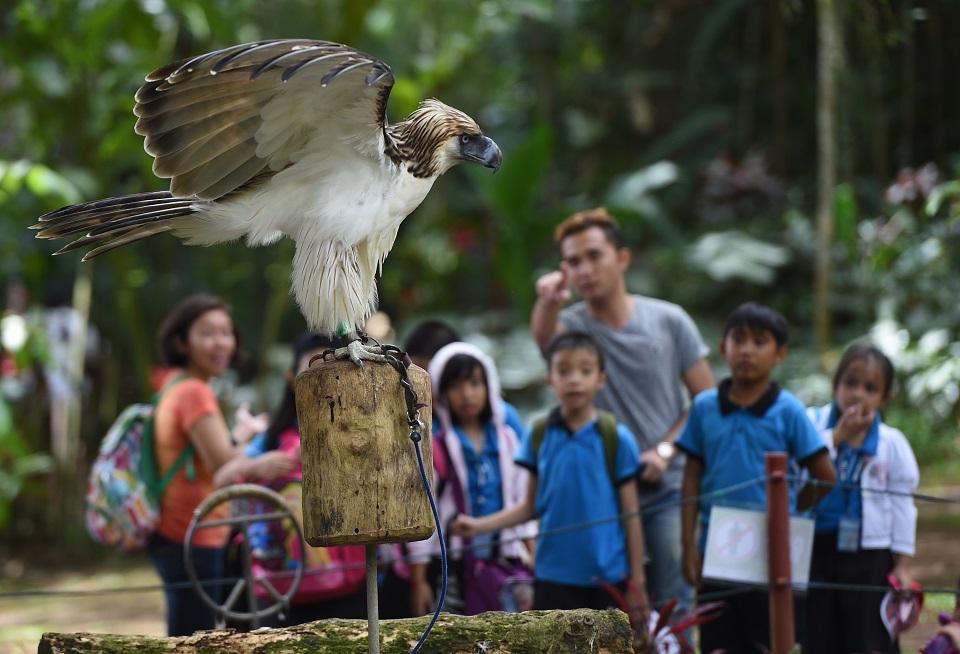Davao sanctuary offers hope for endangered Philippine eagle

DAVAO - Surprisingly loud chirps accompany a clumsy flurry of tiny wings as a wispy-haired chick breaks through its shell, its birth offering rare cause for celebration in the struggle to save the Philippine eagle from extinction.
Tropical rainforest destruction and relentless hunting have decimated the population of the majestic bird—one of the world's biggest and most powerful—with just hundreds believed to be left in the wild.
A small band of conservationists at a tiny sanctuary on the fringes of Davao is trying to ensure their survival by running the world's only breeding program for the eagles and by rehabilitating the wounded.
"The center serves basically as insurance, or a Noah's Ark so to speak, for the species," Philippine Eagle Foundation executive director Dennis Salvador told AFP on a recent visit.
"But it certainly doesn't substitute for a population in the wild."
The foundation estimates there are about 800 of the Philippines' national bird remaining in the wild, though it is impossible to count accurately due to their remote habitats. International conservation groups say there could be as few as 250 left.
In more than three decades of trial and error experiments by the foundation that have yet to fully understand the eagles' breeding habits, just 27 have been born in captivity.
The eagles are notoriously hard to pair, with the larger female known to attack and even kill an unwanted suitor in the wild. Once they do find a suitable partner, it is generally for life, although even in the forests the couples will generally only reproduce every two years.
"It's difficult because we don't really know what happens in the wild, and we can't replicate that here in captivity," said Anna Mae Sumaya, the foundation's curator.
'Exciting, fantastic'
However, after failing to breed any eagles for nearly three years, recent successes have raised hopes.
Go Phoenix, which was brought into the center after being ensnared in a hunter's trap, and MVP, a shooting victim, were successfully paired in 2013 and have produced two chicks in quick succession, the latest in February.
The exceptionally rare moments in nature were filmed from behind glass enclosures, the footage showing chick number 27 breaking out of its shell with a burst of energy and chirping before resting its head on pebbles in a small metal dish.
"It was exciting, a fantastic feeling, we were very lucky," Sumaya said, adding she hoped Go Phoenix and MVP could produce again next season while two other pairs were also a chance to breed.
However a growing problem is space: 35 eagles live in cages of various sizes in the center, which covers just eight hectares of forest.
The center's ultimate goal is to release the eagles back into the wild, but this has proved even more of a challenge than breeding them.
One of the biggest problems has been the eagles becoming too accustomed to human contact at the center. When released, they have been shot after getting too close to communities that are in or near the diminishing forests.
Formerly known as the monkey-eating eagle, the birds are protected by law. Killing one is punishable by a maximum 12-year prison term and a P1 million fine, but shooters are rarely caught.
Out of 15 eagles from the center that have been released, only one is known to still be alive in the wild, according to Sumaya. She said four had been brought back to the center after sustaining injuries while the others were confirmed or presumed dead.
'Devastated'
In the most recent failure, Matatag was shot in February. He had survived about a year after being released into the forests on Mt Apo, the Philippines' highest mountain.
Matatag had initially been brought to the center after being shot when he was just one year old, then spent three years in rehabilitation before his ill-fated release.
"I was devastated. I thought: 'It's happening all over again'," Sumaya said, but added the bird was recovering well.
The center is trying to eliminate contact between humans and the eagles that are earmarked for eventual release, although Sumaya said there were no plans in the near future to set any more free.
Those that are too badly injured or old to be released are put on display for tens of thousands of tourists and students who visit the center each year.
While breeding the eagles is important, foundation executive director Salvador said the key to the eagles' survival was educating Filipinos about their plight and raising awareness about the need to stop logging, mining and other forest-destroying activities.
Four-year-old Fighter spends his days chained to a perch, his grey eyes constantly darting as if he thinks he is searching for prey in the wild, while his striking brown and white crest occasionally flares in a sign of stress or territorial aggression.
Fighter is missing nearly half of his left wing from a gun shot injury so would not survive in the wild, but he is helping to teach visitors about the eagles' plight.
"Just don’t destroy the habitats of eagles, don’t destroy their forests," said nine-year-old Daneen Sinsuat, when asked what she had learnt from her visit to the center with her classmates. — AFP



